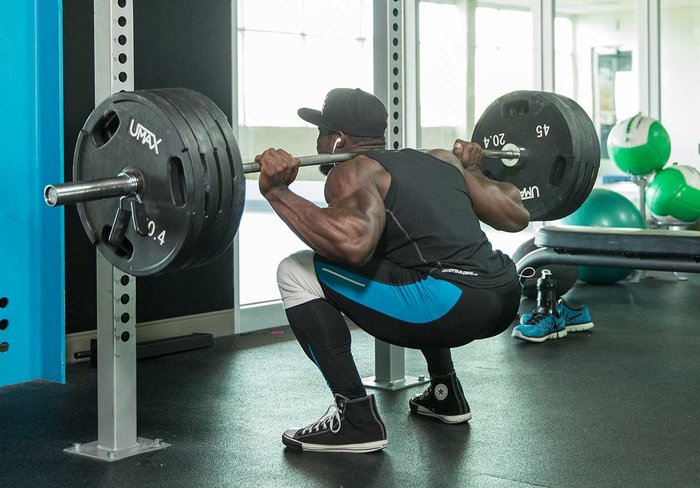One of the (many) accepted "truths" of bodybuilding I've always had a problem with is the notion that if you train for more than an hour, you will become catabolic due to increases in the hormone cortisol. To hear some people describe it, there's a massive reservoir of a toxic gains-melting substance hidden away in your body, attached to a ticking clock like a time bomb.
I understand where people who propagate this idea are coming from, and it's logical at first glance. Bodybuilders want to avoid cortisol at all costs because it's catabolic, right? While this seems very simple, the truth of the matter is actually much more complex.
Cortisol is a catabolic hormone secreted by the adrenal glands. During periods of stress, cortisol is secreted to help the body cope with stress and mobilize fuel by increasing protein breakdown and decreasing protein synthesis.[1] Starting a couple of decades back, muscle magazines made quite a stink about not training for more than an hour at a time, due to increases in cortisol.

However, I have thought of this as an overblown concern for a long time for a few reasons:
- Protocols much shorter than one hour have also been shown to increase cortisol if they are intense enough.[2,3]
- While cortisol increases in response to an intense exercise bout, so do anabolic hormones like testosterone, IGF-1, and growth hormone.
- On a personal note, I followed the mantra of "do not train for more than an hour to limit cortisol release" and had limited success. When I later switched to a higher-volume routine which lasted well past an hour, I saw better gains.
- Nobody has proven anything magical about the 60-minute time frame. It's not as if cortisol sits at baseline, and then suddenly spikes and floods your body traps-to-calves immediately at 60 minutes. It's likely that cortisol release is more related to the stress applied to your body from the intensity of the workout than it is to the duration of the workout. Put another way, I'm confident you'd see a much greater cortisol release from doing a single set of squats to absolute failure than you would from doing 5-pound dumbbell curls for an hour and a minute.
- Cortisol takes much longer to exert an influence than many other hormones. It's not like insulin, a hormone that binds to receptors on the cell surface and almost immediately causes changes in signaling that produce a rapid response. Instead, cortisol operates at the DNA level as what's known as a "transcription factor," and binds to specific sequences of DNA to either increase or decrease their rate of transcription to mRNA.
The upshot is that it takes much longer for those mRNA transcripts to build up and cause some sort of effect than it would for a hormone that functions more acutely, like insulin. Furthermore, just increasing or decreasing mRNA accumulation is not assured to produce an outcome, as the translation from mRNA to their constitutive proteins is also highly regulated.[1]
That may be a bit too much science for some of you, but the takeaway is that the transient increases in cortisol produced by exercise are likely mostly inconsequential and not in and of themselves catabolic. Rather, it is the long term, sustained elevations in cortisol produced by stress and disease that are likely to result in catabolism.
The New Science Of Cortisol
I've been suspicious of the anticortisol message since before I was a PhD, but when I was in graduate school, I had the opportunity to dig into some exercise data to see what it had to offer. And quickly enough, I noticed an interesting trend. Many of the exercise protocols that produced the greatest amount of muscular growth also increased cortisol the most!
So when Dr. Stuart Phillips, a researcher from McMaster University in Canada, published his latest paper on this very topic, I was extremely interested. Dr. Phillips examined a large group of resistance-trained subjects and correlated the increases in lean body mass, muscle hypertrophy (assessed by changes in muscle fiber cross-sectional area), and strength (assessed by leg press) to hormones such as testosterone, IGF-1, growth hormone, and cortisol.[3] What his lab discovered may surprise you.

They found that among the hormones they tested, increases in lean body mass and hypertrophy of Type II muscle fibers were most closely associated with cortisol. That's right: Muscle growth was mostly associated with cortisol. Not testosterone, not growth hormone, not IGF-1, but the supposed king of catabolism!
I am not saying that cortisol is anabolic. More likely, this data indicates that the type of resistance-training protocols that produce the greatest hypertrophy also cause the greatest cortisol release, most likely due to the increased acute-stress response. And yes, you need stress to grow.
But for me, it's also pretty close to being the proverbial nail in the coffin of the one-hour training limit. It is time for bodybuilders to stop focusing on short-term increases in cortisol when designing programs.
Train past the 60-minute mark with no fear my friends.
References
1. Garrett R. H., and Grisham C. M. Biochemistry, 1999. Saunders College Publishing.
2. Kraemer, W. J., Fleck, S. J., Dziados, J. E., Harman, E. A., Marchitelli, L. J., Gordon, S. E., ... & Triplett, N. T. (1993). Changes in hormonal concentrations after different heavy-resistance exercise protocols in women. Journal of Applied Physiology, 75(2), 594-604.
3. Kraemer, W. J., Dziados, J. E., Marchitelli, L. J., Gordon, S. E., Harman, E. A., Mello, R., ... & Triplett, N. T. (1993). Effects of different heavy-resistance exercise protocols on plasma beta-endorphin concentrations. Journal of Applied Physiology, 74(1), 450-459.
4. West, D. W., & Phillips, S. M. (2012). Associations of exercise-induced hormone profiles and gains in strength and hypertrophy in a large cohort after weight training. European Journal of Applied Physiology, 112(7), 2693-2702.


